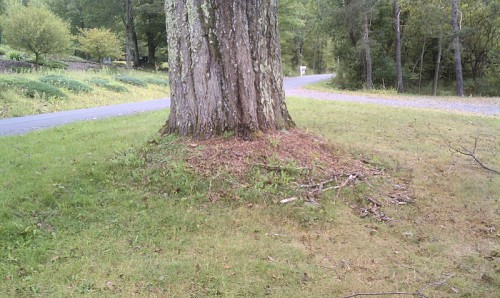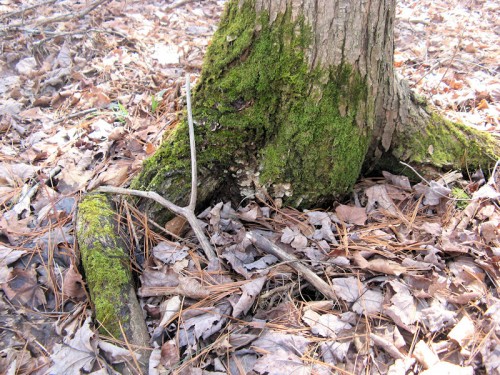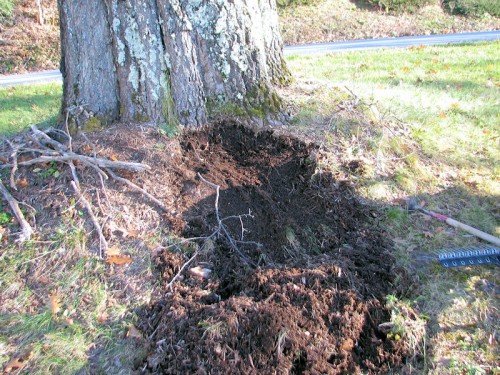Mulch can kill trees–that sounds kind of extreme, doesn’t it? But it caught your attention, right? I suppose it would be more accurate to say improper mulching can kill trees, but as I look around me, improper mulching of trees seems to be the standard practice, the only kind of mulching around trees that’s being done.
The previous owners of our new home appear to have paid a lot of attention to detail and tried to rebuild and remodel everything correctly, so the house would endure. They very considerately left behind a paper detailing the house’s history, in which they say that this oak tree was planted in 1885, the same year the house was built:
You can see that the trunk comes straight out of the ground, like a telephone pole. Compare that to this tree growing naturally in the woods of our old home: While the previous owners took great pains when remodeling the house, they apparently didn’t realize that the way they mulched the trees would eventually kill them. I’m sure they wanted the trees to live as long as possible, especially a tree so intimately connected to the history of the house itself.How does mulch harm trees?
When you put mulch around the trunk of a tree and cover the root flare, you are covering up parts of the tree that were meant to be exposed to air. The excess moisture can cause rot, but the trunk of the tree is supposed to have access to air, and by piling up mulch against the bark you are preventing this. If the mulch is left there long enough, the tree will try to compensate by growing adventitious roots. Unfortunately, these same roots can wind up wrapping around the tree and girdling it. Figure 11 on this article written by a tree preservation expert illustrates this girdling in progress. The tree winds up killing itself. So we have three ways improper mulching can kill a tree:
- rot
- suffocation
- girdling
In addition, the stress of improper mulching could make the tree more vulnerable to a secondary problem, such as an insect infestation.
Uh-oh. How do I fix this?
You need to remove the excess mulch from around the tree. I’ve started doing that with the oak that I mentioned previously.
Just about every tree on the landscaped part of the property has this problem. I can even see some landscape fabric peeking out of the mulch around one tree. It’s going to be a big job, but at least the decomposed mulch from around the trees will make a good soil amendment for the native clay that the shrubs and perennials are planted in. If your trees have been buried for a long time, you might want to visit the resources listed below, and then consult an arborist in your area.So what’s the right way to mulch a tree?
According to Marianne Ophardt, a Washington State Cooperative Extension Agent writing for the Mid-Columbia Community Forestry Council, you should keep the mulch “six inches away from the trunks of young trees and one foot away from the trunks of older, mature trees.” Ideally, the mulch will be in a 2 to 4 inch layer extending out to the drip line, because lawn grass releases chemicals that inhibit the growth of trees. Not many homeowners with large trees want such vast expanses of mulch. Trees can grow in lawns, but more slowly. The most important thing is to avoid burying the tree flare.
Why does this happen?
I can understand why homeowners over-mulch their trees. They’ve heard that mulch is good for plants in general. They know that string trimmers can damage the trunk. But they want to have their lawn looking neat without getting off their riding lawn mowers if at all possible. It seems like the way to accomplish that is to mulch right up to the trunk, and mow right up to where the mulch and grass meet. I guess people spend so little time nowadays around naturally growing trees that the lack of a tree flare doesn’t bother them, or they think it doesn’t matter.
But I have seen plantings of trees around businesses, obviously hired out, that have “mulch volcanoes” around them. You would think a professional landscaper would know better. Could it be that their clients actually prefer the volcano look, and insist on it? What do you think?







This is a terrific article and the photos work really well with the content. Fall is a great time to get this reminder out to the masses. More is not always better! Thanks so much
We are students from the University of St. Thomas and are working on a project concerning a spray-on mulch colorant. The product is Hippie Mulch and we would appreciate your insights on mulching, spray- on mulch colorants, and social media. All of your answers will remain confidential. The survey should take you no longer than 5 minutes. Thank you for participating.
http://stthomasbusiness.qualtrics.com//SE/?SID=SV_6fgeKqVa0bal1ys
This is a problem here in Western NY. Catt. Co. I have been working on our trees that have been mulched incorrectly. Almost every tree one our road. Amazing the lack of knowledge. Gotta share the info though.
Really why do people mulch so high and so close to a tree? There has been an effort here in Chicago ,by the treekeepers of Openlands, to educate the public on planting and maintaining trees. They call the mulch circle a donut and send out volunteer crews to different parks all season long to properly apply mulch. This means that a few wispy grass or weed stems must be clipped on occasion,if you must have it totally clear, but is worth it in added years to the trees life. Really this is only a problem if lawn is growing near the tree. Not so much of a problem if you rethink the idea of lone trees circled by lawn.
How can I contact Openlands and get involved in educating about mulch? I see many CITY facilities and plantings that are being over-mulched, and now the neighbors are copy-catting. It’s breaking my heart to know that trees that survived 100+ years will be damaged and killed in only a few years by all this over-mulching.
Excellent post. I’m always horrified by what professional landscaper do to the trees where I live. A Scots Pine came down across a main city road 2 weeks ago and everyone was shocked, but it was clear for years that the Council were rotting the base by constantly raising the soil level around those trees. I’m just amazed that only one fell in the gales…I’m sure the others will follow.
Great post! This is a serious problem, even so so called professional landscape companies often mulch too heavy. I have had to consult on several situations where the dying tree was a direct result of the much volcano.
I have been known to rake the mulch back from trees under the cover of night in my neighborhood.
Thank you for the post. I don’t know what bothers/concerns me more… over mulching or tree coffins. Cement surrounded or mulch surrounded, both are terrible.
Interesting article.
Reminds me of recently when here in my garden at Botanic Bay, a tree expert came round and condemned a very sickly looking Silver Birch. he explained that in fact the previous owners of our house had in fact buried the root bole of the tree too deep and heeped earth high up around the trunk which did not permit the rooting system to grow properly.
Take care when planting trees!
Céline.
I love thinking of you settling into your new landscape, which always means finding the problems others have left behind. I can understand the errors made by homeowners, but so many of these mulch volcanoes are the work of ‘professionals.’ This is really despicable.
Mulching is kind of helpful too but obviously it is not the natural thing as the leaves covering the bottom portion of the tree like in Wildness. But you are right that it is killing the plants with Kindness
Hi Kathy,
I’ve enjoyed reading your posts! Over mulching is such a problem in southern New Jersey where I live. Over the last 20 years or so a lot of farm land has been converted to housing developments. I too wrote about it several weeks ago. 90% of the homes look the same and I believe residents have been “conditioned” to believe the perfectly manicured lawn with the mountains of mulch around shrubs and trees is a good thing. Drives me crazy! I would bet anyone this spring, as the weather begins to turn, I’ll be able to drive down any street and take pictures of the mountains of mulch delivered onto driveways to begin the process all over again. Hopefully our message will get out… 🙂
Kathy, I was made aware of this many years ago and have always adhered to it. Many gardeners damage their Rhododendrons with bad practice mulching such as this. I do believe that the professionals don’t bring this problem to our attention often enough, indeed many may not be aware.
I don’t know why you’d mulch an established tree at all. What good could come from pouring mulch right at the trunk when the roots are all spread far and wide? I agree that it’s a case of if something is good, then people think the more the better, and they treat tomato plants and oak trees alike…
Great post, Kathy! You have a lot more wisdom than many who work in the landscape industry.. this is so often seen – especially after a property has just been landscaped and each tree has been surrounded with a mountain of dark mulch that forms a tall pile. Thanks for sharing!
Kathy,
Your post made me run outside and take a look up and down our block. Sure enough, at least half of the trees I spied looked like telephone poles coming up out of a mound of mulch, grass or leaves, including that of a neighbor who lost a huge limb this last week in a wind. She had earlier lost an entire tree when it’s trunk split in zero wind, both with volcano mulching. It also doesn’t help that we have a street lined with mature sweet gum trees, which are brittle as all get out.
Yael
Very informative and well researched post. Thank you. I came across just this problem the other day with some tough as old boots rugosa roses rotted at the base of their fat old stems. Quite clearly killed as you describe.
Great article, Kathy. I’m stunned how many trees are planted incorrectly, then people wonder why they die a few years later. Enjoy your new landscape!
The only thing that that makes a much volcano worse is to use that hideous dyed red mulch. I was at a presentation last year where landscaping mistakes were being made fun of (for educational purposes), and a picture was shown where every tree in the shown garden had a red mulch volcano at the base. The utility poles and street signs were treated the same way.
Kathy,
Thanks for this reminder in your thorough, yet concise article.
Is it okay to link to your post from my blog to use this article as a resource for readers/clients?
I think people like mulching right up to the tree bark because their primary concern at the time is keeping moisture in (especially with newly planted trees) and weed suppression. But as you point out so well, none of this will matter if the tree can’t breathe.
I find that another problem with new trees and too much mulch is that it can attract trunk-girdling rodents, especially in fall.
Best,
Megan
Those volcanoes are spreading everywhere, and because people see them on “professionally” groomed areas, they assume that is the correct procedure to use. I really like the idea Gail proposes of having nurseries and big-box stores with nursery departments offer NOT just instructions for proper planting (because most trees come with them and people ignore those), but WARNINGS about the dangers of improper mulching. In our former house, the owner tightly surrounded their beautiful tall oaks with plastic, well above the flare, then covered that with several inches of crushed stone. When we moved in and tried to remedy the situation, we found that the plastic had grown INTO the bark of most of the trees, effectively girdling the lovely, mature trees, which were already well on their way to dying. SO unnecessary!
Great post, Kathy. This is a pet peeve of mine.
Hi Kathy!
Are you completely sure that this wasn’t just a result of planting the tree improperly? Even more than excessive mulching, I notice trees having problems from being planted too deeply. Maybe it’s both.
Anna, if it was a young tree, I might wonder if it were planted improperly. But the tree we are talking about is over one hundred years old. If it had been planted improperly it would have died years ago.
Good post, Kathy. I wonder if “professional landscapers” and mis-guided homeowners will every figure out the proper way to apply mulch around a tree.
Very good article Kathy. Volcano mulching is very bad for trees. When working as an urban forest technician it was a continuous educational effort. Many landscape companies routinely mulch this way because the affect is very formal. Most of these landscape “professionals” have no education about the proper mulching techniques. They may read trade journals that recommend the practice to increase profits. I’ve seen homeowners copy it because that’s what the professionals do.
Oh, this is such a pet peeve of mine! It’s not just your neck of the woods, so to speak, this is a nationwide problem. I haven’t traveled abroad recently, so I don’t know if this terrible practice has spread beyond our borders. Who started this mulch volcano craze? I want names….
I see this tree mistreatment all over the city. I would like to see planting and care instructions going home with every homeowner who purchases a tree~The big box stores and independent nurseries could start an education campaign. gail
Kathy, that’s so very true. I’ve seen those mulch volcanoes here, and they do kill trees. It’s like to killing them with kindness.~~Dee
You have explained this so well, Kathy! Every homeowner should read this, to help their trees be healthy and live as long as nature intended, with the flare exposed. I guess that people are so used to seeing the volcanoes, they assume that is the proper way to mulch a tree, sad to say. That does look like a huge undertaking, to uncover your trees, but you will have good soil to work into beds. Maybe you can get some help, somewhere.